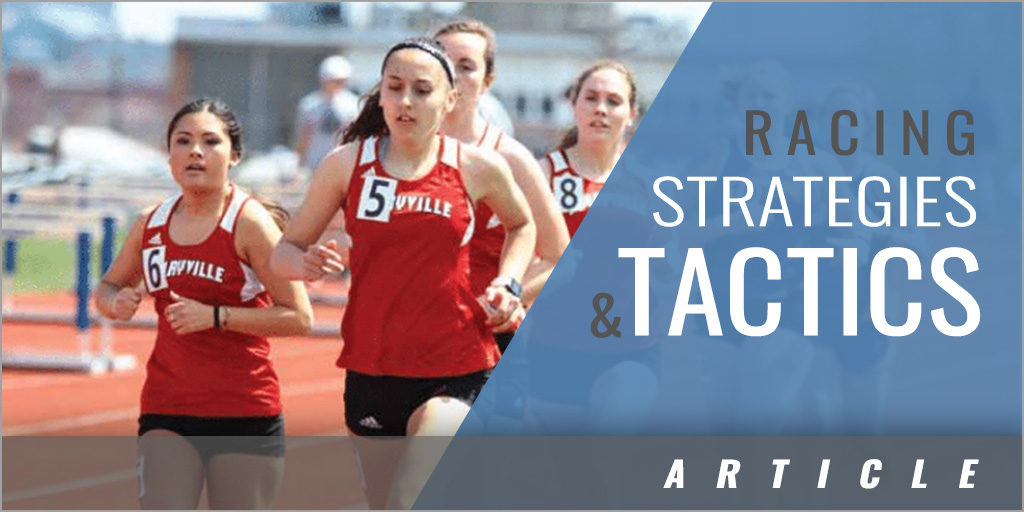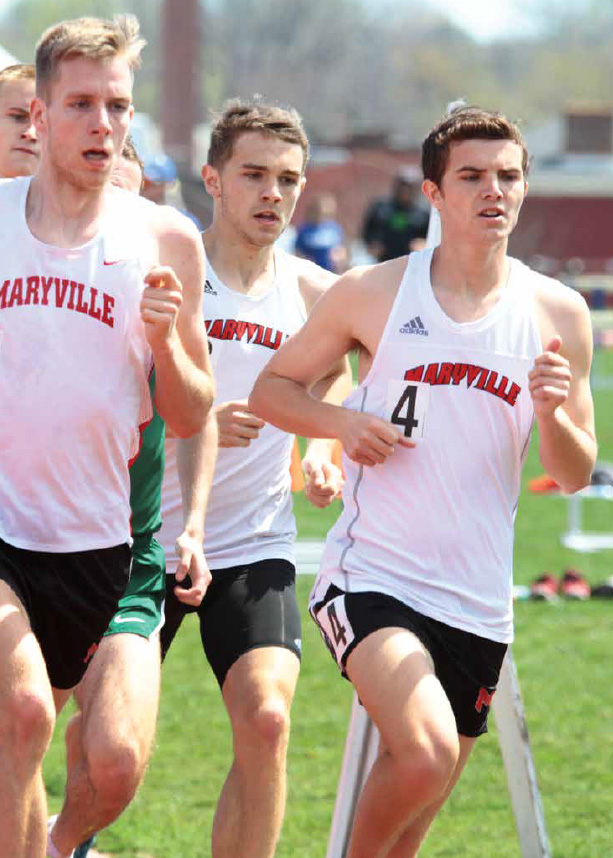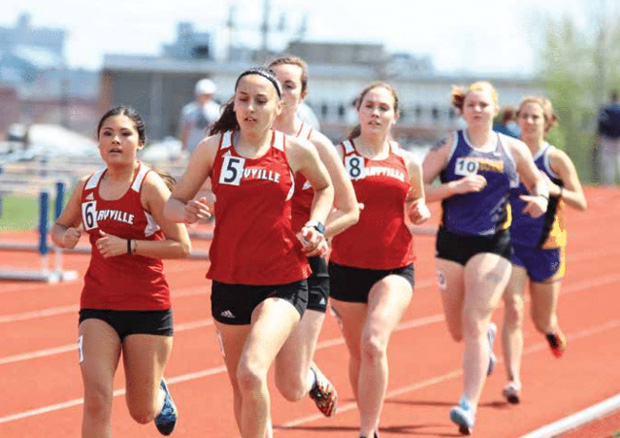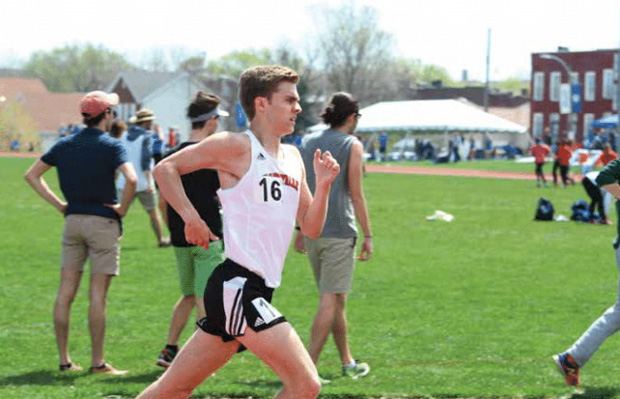|
By: Timothy Makubuya and Micky Kaufman Originally Published in: Techniques Magazine Provided by: USTFCCCA
Athletes of all kinds are often challenged when deciding racing strategy and tactics for particular races. Obviously, no one suggestion will allow the athlete the ability to wane off the pressure often arising from the adrenaline that is secreted prior to the start or firing the gun. However, the decisions made from the start to the finish can have significant impacts on the outcome of the race. These decisions are often what dictates following conversations of regret or rejoice that these athletes have at the conclusion of their races with their coaches and teammates. Racing strategies and tactical decisions are tough to make for many athletes in the race, and require education and practice to become competent and confident. Through various ways, coaches can help their athletes in applying strategies that work best. Adhering to a certain routine and becoming confident with the results of a particular strategy is beneficial, but there may be times where athletes need to abandon what they are used to if they want to optimize their success. In this article, we offer suggestions on how coaches and athletes can utilize common racing strategies (which we will define as a general race plan) and race tactics (which we will define as specific actions) in middle distance events. The key to this however, is for the athlete to try out and figure out what works well for them based on how the race unfolds as well as the strengths and weaknesses possessed by themselves and their opponents. STRATEGIES Our approaches are governed by constantly trying out different racing strategies, such as front running, sit and kick and time trial. FRONT RUNNING Front running normally involves a runner who takes the lead during the first third of the race and pushes their pace with the confidence that they can sustain the effort better than the other competitors. The goal here is to have their competitors too far back or have them fatigued to the point where they are unable to use a strong finishing kick or end spurt to win the race. There are numerous athletes who strongly believe in this technique. To them, front running with an intention to run a positive split, would serve them best. We can also term this approach the, "catch me if you can" strategy. This strategy can be employed successfully by athletes who believe that they do not have the strongest finish in the race or by those who feel the race is too slow to obtain their goals in the race. David Rushida won a gold medal in the 800m while setting the Olympic record in 2012 finals while using this strategy. SIT AND KICK The sit and kick strategy involves a runner who positions him or herself in contention, but not in the lead throughout the majority of the race, allowing other runners to expend additional mental and physical effort, while conserving energy themselves. This strategy involves a runner who picks a point in the last half of the race, with a goal to take the lead. This strategy is employed by athletes who believe they have the strongest finishing kick in the field. The 2016 Olympic 1500 meter Women's finals is an example of a race where the winner, Faith Kipyegon, demonstrated a successful use of the sit and kick strategy. TIME TRIAL Often, we have noticed athletes trying to set records utilizing what we have termed the time trial strategy. This strategy will many times utilize a rabbit for pacing purposes that tries to run as even of a pace as possible through the first three-fourths of the race without much variation in speed and target to kick to a personal best. This strategy is perceived by many as being the best opportunity for energy efficiency in the 1500m and 3000m middle distance events. Hicham El Guerrouj used this strategy in 1999 to set the world record in the mile running lap splits of 55.6, 56.0, 56.3 and 55.2. Athletes may display a combination of these strategies which allows them to mentally process the race based on their physical strength and the race situation that is determined by the strategies of the other runners. In each of these strategies, the goal is for the athlete to determine what would best serve his or her ability to achieve the goals of the race. Examples of racing goals may include; running a season best, winning the race, or obtaining a qualifying mark. TACTICS For purposes of building a practical discussion on the importance of some specific race situations that we believe are under communicated, we want to reflect and highlight a few of the many tactics that can help an athlete succeed. START In middle distance events, the starting strategy and position is an important aspect of the race. It is our belief that training the start is a much underutilized aspect of training in many running programs. Often, we see athletes that lose precious tenths of a second on the start that severely hampers their positioning in the beginning of the race. There are a couple of things to note at the start of the race. First, are the arms. Many athletes will start with the same arm and leg forward at the start of the race, then when the gun goes off, the arms will do a quick switch of arm position, even before the body is moving forward. In this case, the athlete will lose time and/or distance on his first step in the race. The athlete's arms should start in a position so they can make one big arm swing with their first step with a less exaggerated arm swing than that of a sprinter coming out of the blocks. Athletes also loose time by starting their wrist watch. Starting a watch in a race hampers the ability of the athlete to perform necessary arm motion at the beginning of the race. In this case, the athlete has both arms in front of their body which will cause them to loose of the effectiveness of their first arm swing. Secondly, we look for the weight distribution on the legs and how the first step is made. It is important that the majority of the athlete's body weight is on the front foot. This will provide a bigger load for the athlete on that leg that will make longer quicker initial steps in the race. A common mistake that runners make at the starting line is having a distribution of weight that is almost evenly split. This may cause the runner to take their first step with the front foot or in some cases even a small backwards step with the front foot before moving forward. A slightly slower start or loss of distance off the first step causes the athlete to have to expend more energy later in the race in an attempt to regain that position. This will cause the athlete to run subsequent extra meters over the duration of the race because of not having a spot on the turn near the curve on the first lap.
CUTTING IN Races that use a cut-in line also allow for a certain type of tactics. It is overwhelmingly assumed that running a straight line from the break to the turn is the best way to run the race so that an athlete is running the shortest possible distance. However, this may be short sighted. Whether running in lanes, alleys, or off a waterfall, by starting to run a straight line to the turn could end up costing you extra distance later on. Typically, what we notice in high school and college races is that very few runners will run the straightest line especially when the race is so packed that there is more competition between the start to around the 50 meter mark. Obviously, it should be every runner's goal to run the shortest distance, and this might require a sprint to the lead or tuck in last place so they are not running extra distance on the turn. If they are the last one to complete their cut-in, they will likely be stuck on the outside of the group unless they are in first or last place. The advice here is to keep this in mind as you develop your overall race strategy and to practice cut-ins, as it may not be beneficial to always run the straightest line off the break line. If a runner is in the first position or alley this provides some other challenges or factors to consider. We suggest that runners that draw inside lanes to stay off the rail or inside line at the break. The other seven to twenty runners will soon be coming in trying to share that space with the possibility of boxing that runner in, cutting them off, or making contact to disrupt the rhythm they have set. Running off the rail in the middle to outer portion of the first lane will allow the athlete a little more movement and a lesser possibility of being negatively affected by these issues in the moments after the break. This may cost the athlete extra distance at the beginning, but it could also save them extra distance as the race goes on. LANE POSITIONING Two discussions on lane positioning in middle distance events include; being "boxed-in" while running on the inside of lane, and running on the outer side of the learn. First, being boxed is a term that is used when a runner has athletes both directly in front of him/herself, and to their right. This impedes them from being able to improve their positioning without slowing down to go around and accelerate. Most athletes are typically taught that being boxed in a race is a detriment and therefore, try to get out of the box as soon as possible. This will occasionally cause athletes to make unnecessary energy wasting surges in a race, or run in outside lanes which increases racing distance. It is important for the athlete to know that being boxed is only deleterious if a faster pace than those who are creating the box is desired or if a breakaway commences a head of the boxed-in athlete, in which they would like to initiate a response. However, when considering the latter, odds are that when a breakaway is being conducted, the box that an athlete is in will also break up (not always, but usually). So, in most instances it is encouraged to train your athletes to be patient and allow the box to break up rather than slow down to sprint around if they find themselves in that position.
Alternatively, another way to help avoid being completely boxed is to run on the outside of the inner lane on the shoulder rather than directly behind the competitor. In this case, it usually only takes another small step or two to the outside to avoid a developing box and allow proper positioning to respond or begin a break away. Also often discussed is running on the inside of lane one, so that you are running the shortest distance. Advice on how to do this will often counter the advice on how to avoid being boxed in. After all, the most likely place to be boxed is in lane one, where an athlete might run the shortest distance. This is where the art of racing and coaching is more critical than the science, and here, many different strategies may be employed with success. The athlete's goal(s) of the meet may need to be pre-determined as sometimes the goal is to race for time or race for place. With that in mind, the following rules of thumb should be considered but not necessarily adhered to in every situation. If athletes are in front of a pack or are in a lonely spot in the race it is best for them to stay in the inside part of lane one. If athletes are in a box that is moving at the desired speed, then it is better to be boxed running in the inside lanes than running the same speed unboxed in outside lanes. If an athlete finds themselves boxed in a situation they are ready to make a break, then they should slowly (to avoid contact) position themselves to the outside of the track until an opening becomes available to make their break. The positioning an athlete at the beginning of the race, could sometimes also offer the necessary advantage especially in seemingly overcrowded races. Every athlete aiming to post a better time, or qualify for a major event would want to be at this advantage to start out as fast as possible and avoid being boxed in. From observing runners who start their 800m at different waterfalls, you will notice that athletes at different positions would get through the first curve as fast as possible to avoid getting boxed in. This is a crucial moment when racing for time. Coaches need to find ways to communicate with their athletes on how to avoid being compromised. We also know that in many cases, athletes have little influence of starting positions, especially when positions are predetermined by the starter. In the 800m race that starts on the lane or staggers rather than the water fall, the athletes would still have to cross over as fast as possible to aim for front or leading positions on their first back stretch. HALF WAY Although the time one crosses the midpoint of the 800m race doesn't necessarily determine how fast they will cross the finish line, we could learn a lot from techniques we apply to pass through this midpoint of the race. From examples that we have used, it's evident that there are mainly three types of 800m athletes; those who go through as fast as possible, and those who slowly pickup their paces, and build into the final end, and those who simply just hang on. It is similar to note that at this point in the race, most these athletes have similar biomechanical display of form, posture, arms swings and leg actions that are positioned in FINISHING KICK There are a few factors to consider when deciding when to start your finishing kick. Strength and weaknesses of the athlete and opponent is the most important. Other factors include the race dynamics (in other words, how the race has played out up to that point), and the goal of the race. The discussion here will focus on a couple of smaller strategies that are underused. One such strategy that can be used when racing for place or a win in a race (while using a basic sit and kick strategy at the end of the race an athlete), can be, being hesitant to decide where to make their final surges to the finish line. Many times athletes will try to wait until a straightaway with 300m or 100m to go in the race for fear of wasting time, distance and energy passing someone on a turn. However, waiting until the straightaway does not give them enough time as the runner in front has that one or two extra step advantage and there may not be enough time to catch them if they have a near equal finishing kick. This approach can be modified to give the athlete a high probability of surpassing the competition. Tactfully waiting or "sitting on the opponent" through the first half of the curve, then proceed to swing to the out-side in the second half so that you are As one approaches the last curve of any of these races, they are probably already in their final kicking or sprinting mode, or they are about to initiate the kick. Again, remember, this is dependent upon individual athlete, coaches' direction, and what the athlete can still accomplish. CONCLUSION Coaches should incorporate racing practices aimed at allowing athletes to try out the various racing scenarios to determine what works best for them. Such can be be implemented during practice and at time trials, before being executed in an actual REFERENCES Kahrovi, I., Radenkovi, 0., Mavri, F., & Muri, B. (2014). Effects of the Self-Talk Strategy in the Mental Training of Athletes. Physical Education and Sport, 12(1), 51-58. Hagger, M. S. [Ed], & Chatzisarantis, N. L. D. [Ed]. (2007). Intrinsic motivation and self-determination in exercise and sport. Intrinsic motivation and self-determination in exercise and sport. (pp. 281-296) Ryan, R. M, & Deci, E. L. (2007). Active human nature: Self-determination theory and the promotion and maintenance of sport, exercise, and health. In M. S. Hagger & N. L. D. Chatzisarantis (Eds.), Intrinsic motivation and self-determination in exercise and sport (pp. 1-19). Champaign, IL: Human Kinetics. Schaefer, I., Vella, S. A., Allen, M. S., & Magee, C. A. (2016). Competition Anxiety, Motivation, and Mental Toughness in Golf. Journal of Applied Sport Psychology, 28(3), 309-320. Goater, J. & Melvin, D. (2012). The Art of Running Faster, Champaign, IL https:11www.trackandfieldnews.comindex.phplcategwy-stats11932-splits-inworld-record-miles. Timothy Makubuya, Ph.D. is Assistant Professor of Physical Education and Exercise Science at University of Missouri- St. Louis. He is also an Assistant Track and Field Coach at Maryville University in St. Louis. Micky Kaufman is the Head Track and Field coach at Maryville University in St. Louis. Coach Kaufman is also the Coordinator of the Healthy Kids Running Series program in St. Louis. |










